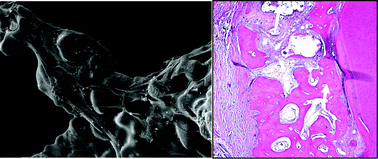Bioactive scaffolds play an important role in periodontal tissue engineering. Nagelschmidtite (NAGEL:Ca7P2Si2O16) is a newly synthesized bioceramic which can stimulate the proliferation and osteogenic/cementogenic differentiation of periodontal ligament cells (PDLCs) for potential periodontal regeneration. The aim of this study is to prepare porous NAGEL scaffolds and to systematically investigate their in vitro and in vivo osteogenesis/cementogenesis. The NAGEL scaffold with highly porous structure and large pores was successfully prepared by a spongy-templated method. The interaction of the NAGEL scaffold with PDLCs was studied by investigating cell attachment, proliferation and osteogenic differentiation of PDLCs. NAGEL scaffolds were implanted into the periodontal defects of beagle dogs to evaluate their in vivo osteogenesis/cementogenesis. The results showed that NAGEL scaffolds supported the attachment and proliferation of PDLCs, and significantly enhanced osteogenesis/cementogenesis-related gene expression of PDLCs, compared to β-TCP scaffolds. The in vivo study showed that the rate of new bone formation in NAGEL scaffolds was higher than that in conventional β-TCP scaffolds, which was evidenced by the significantly improved BSP and OPN expression at both 4 and 8 weeks. The results suggested that NAGEL scaffolds could be used for periodontal tissue engineering with significantly improved in vitro and in vivo osteogenesis/cementogenesis.

